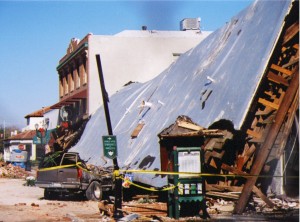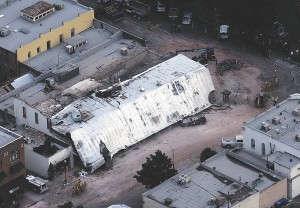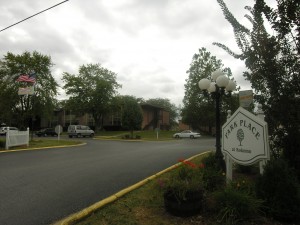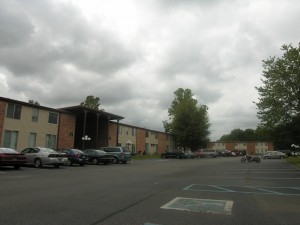Who’s to blame for a natural disaster?
PASO ROBLES, CA–On December 22, 2003, around 11:00 a.m., a 6.5 magnitude earthquake struck near San Simeon off the California coast.
The small town of Paso Robles, 25 miles inland, was hardest hit. Its historic downtown saw many injuries and extensive damage.
There were two fatalities. Marilyn Zafuto, 55, and Jennifer Myrick, 19, died as they fled the shaking in Ann’s Dress Shop. When they reached the sidewalk, the building collapsed on them.
The collapsed building had been a local landmark. Built in 1892, it was known as the “Acorn Building” for its distinctive clock tower and acorn-shaped roof line.
The Acorn Building was owned by the Mastagni family. The elder Mastagnis, Armand and Mary, married in 1946 and raised three childrena as he worked as a dairyman and nurseryman and she ran a dress shop. They acquired the Acorn Building in 1973.
Armand and Mary managed the building together until 1995, when Armand suffered a series of strokes. As Mary took on more responsibilities, the couple established a family trust and transfered the building into the trust. Later, they transfered a 3% interest in the building into a separate trust set up for their three adult children. After Armand died in 1997, Mary became sole manager of the building and signed leases both on behalf of her family trust and on behalf of the children’s trust.
These details of the building’s ownership are of consequence because, when their survivors sued for wrongful death of Zafuto and Myrick, plaintiffs sued Mary, individually, and all the trustees (Mary and the three children).
At trial, plaintiffs argued that defendants were negligent in failing to perform seismic retrofitting of the 1892 brick and mortar building. Beginning in 1989, the city had inventoried unreinforced masonry buildings under its jurisdiction. The city identified the Acorn Building as potentially hazardous and sent a notice to the owners in December 1989.
Later, in 1992, the city passed an ordinance requiring owners of unreinforced masonry buildings to retrofit them to comply with earthquake safety standards. Under the ordinance an owner would have 15 years from the date of official notice to complete the retrofitting. The Mastagnis got their notice in November 1993. The city amended the ordinance in 1998 to extend the deadline for compliance to 2018. The Mastagnis did not perform retrofitting prior to the earthquake.
The jury found for plaintiffs, and awarded $700,000 in the death of Marilyn Zafuto and $1.2 million in the death of Jennifer Myrick. The judgment made each defendant jointly and severally liable as to all damages. The Mastagnis appealed.
On appeal the Mastagnis argued they had not been negligent because retrofitting was not required until 2018. They said the city ordinance represented a balancing of safety, public interest and costs and, as such, it reflected the city’s determination of what was reasonable.
The Court of Appeals disagreed, saying compliance with laws is not a complete defense to a tort action. Instead, the court said, “a statute, ordinance or regulation ordinarily defines a minimum standard of conduct” and does “not preclude a finding that a reasonable person would have taken additional precautions under the circumstances.”
The court also disagreed with the Mastagnis’ argument that each defendant should be liable for only a portion of the judgment, based on the jury’s calculation of their degrees of responsibility. For example, the jury found Mary Mastagni individually 30 percent responsible for the deaths, and the trusts 45 percent responsible. But, as the Court noted, the jury also found defendants operated the building as a joint venture and, consistent with partnership law, each partner is jointly and severably liable for partnership obligations, without regard to their partnership interests or, in this case, responsibility.
Moral: Because the Mastagni children were sued as trustees, presumably the judgment is enforceable only against their trust assets (mainly, the Acorn Building). Mary, on the other hand, may not fare as well since she was also sued in her individual capacity.
The Mastagnis may have liability insurance to cover this mess. Either way, owners should be mindful of this risk when shopping for commercial general liability insurance.
The case is reported as Myrick v. Mastagni, 185 Cal.App.4th 1082 (Cal. App. 2010).





